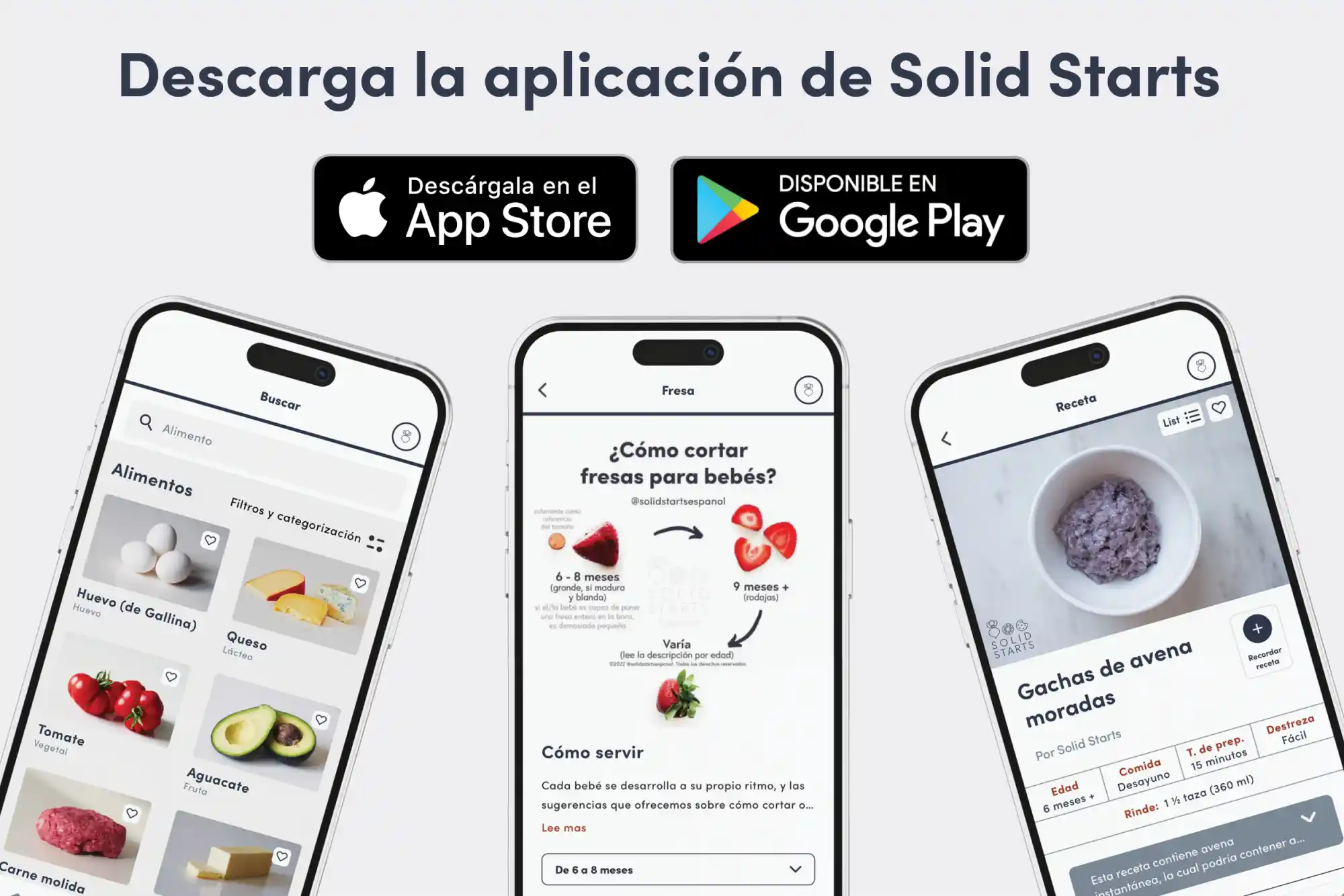Acceda a la base de datos First Foods® en Solid Starts App.
Leer másHorseradish
Vegetal
Sugerencia de edades
6 meses
Alto contenido de hierro
No
Alérgeno común
No

When can babies have horseradish?
Horseradish may be introduced as soon as baby is ready to start solids, which is generally around 6 months of age. Consider starting with a small amount of horseradish mixed into baby’s food, as it can be quite spicy.
Horseradish is part of the Brassica family, a relative of vegetables like cabbage and turnip, and likely originated in Eastern Europe and West Asia. Its name in English has nothing to do with the animal “horse”, but is rather an older meaning of the word, meaning “strong,” a nod to its pungent flavor. Thanks to this peppery taste, horseradish is often used in small amounts or mixed with other ingredients in dips, dressings, or sauces, such as chrain, khrenovina sauce, and pepperrotsaus.
How do you serve horseradish to babies?
Cada bebé se desarrolla a su propio ritmo, y las sugerencias que ofrecemos sobre cómo cortar o preparar determinados alimentos son generalizaciones para una amplia audiencia.
6 months old +:
Let baby taste food that has a small amount of grated horseradish in it, either fresh or pickled, if desired. Consider waiting until baby is a little older to regularly offer very spicy dishes. The goal is to help baby learn that food is enjoyable, and spicy food may make baby feel uncomfortable. Note that horseradish and other spicy foods can cause coughing. You can help balance the heat by mixing grated horseradish with other foods (like applesauce or sour cream) or cooking it slightly.
12 months old +:
Serve grated horseradish, fresh or pickled, or other horseradish products to the child’s taste in meals. Add grated horseradish to sauces for drizzling onto the meal or into a dip for other foods. Note that horseradish and other spicy foods can cause coughing. You can help balance the heat by mixing grated horseradish with other foods (like applesauce or sour cream) or cooking it slightly.
Videos
Is horseradish a choking hazard for babies?
It can be. While grated horseradish presents a low risk when safely prepared for a child’s age and developmental ability, thick pieces of raw horseradish are firm, rounded, and challenging to chew, qualities that increase choking risk. To reduce the risk, prepare and serve horseradish in an age-appropriate way as described in the How to Serve section. As always, make sure you create a safe eating environment and stay within an arm’s reach of baby during meals.
Learn the signs of choking and gagging and more about choking first aid in our free guides, Infant Rescue and Toddler Rescue.
Is horseradish a common allergen?
No, horseradish is not a common food allergen, although reactions to horseradish have been reported. Horseradish is part of the cruciferous vegetable family and individuals who are allergic or sensitive to other members of the cruciferous family, such as mustard greens and broccoli, could theoretically be sensitive to horseradish as well.
Horseradish’s characteristic pungency is due to a chemical called allyl isothiocyanate. When handling grated horseradish, make sure to wash the hands and any skin that comes into contact with the horseradish, as it can be irritating to the skin and cause contact dermatitis. Spicy foods like horseradish may cause a harmless rash around the mouth while baby eats or may contribute to diaper rash when consumed in larger quantities. Try applying a thin layer of barrier cream or ointment—such as pure petroleum jelly or a plant-based oil/wax balm—to baby’s face and diaper area to help prevent contact rashes.
Processed horseradish products may be preserved with sulfites. Certain individuals, particularly those with asthma, can have allergy-like reactions to added sulfites. If sulfites are a concern, avoid ingredients such as sulfur dioxide, potassium bisulfate, potassium metabisulfite, sodium bisulfite, sodium metabisulfite, and sodium sulfite.
As you would when introducing any new food, start by offering a small quantity for the first few servings. If there is no adverse reaction, gradually increase the quantity over future meals.
Is horseradish healthy for babies?
Yes. While horseradish isn’t typically consumed in amounts considered nutritionally significant, it does offer various nutrients like fiber, vitamin C, and folate, as well as antioxidants to support the body’s resilience against stressors and glucosinolates, which may offer anti-cancer properties.
Contrary to popular belief, babies can enjoy big flavors, including heat from ingredients like horseradish, but it is important to start with small tastes and adjust the spice level to suit the child. The goal is to avoid a negative experience from too much heat. Taste the dish before serving, and if the dish seems too spicy, adjust the seasonings to mellow the flavor.
★ Tip: Balance the heat by serving horseradish alongside creamy foods like mashed avocado, plain yogurt, or age-appropriate milk, like breast milk, formula, or cow’s milk.
¿Cuánta comida debo servirle al/a bebé?
Al comienzo, ofrece una pequeña cantidad y confía en que tu bebé sabe cómo mostrar interés si quiere más haciendo ruidos, gestos, o gritando o extendiendo la mano. Ten en cuenta que la mayoría de los bebés entre 6 y 9 meses de edad no consumen muchos alimentos sólidos al principio. Para los bebés de entre 10 y 12 meses de edad, enfócate en ofrecer el equivalente a una comida equilibrada para adultos, pero con porciones más pequeñas. Pon atención a las señales que te da el/la niño/a: cuando el/la bebé te muestre que desea “más”, ofrécele más comida. Cuando el/la bebé muestre señales de “ya terminé”, para de ofrecerle comida.
¿Qué utensilios necesito para empezar?
¡Ninguno! Sirve los alimentos sólidos directamente en la bandeja, plato o tazón del/a bebé y luego deja que el/la bebé explore con las manos. Si lo deseas, tenga una cuchara o un tenedor disponibles para ayudarlo/a a familiarizarse con los utensilios, pero no se espera que adquiera las habilidades para usarlos hasta que sea un poco mayor.
Nuestro equipo
Escrito por
Consejos de expertos directo a tu bandeja de entrada
¡Suscríbete y recibe correos semanales con recetas, consejos y más!
Copyright © 2025 • Solid Starts Inc








